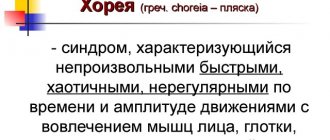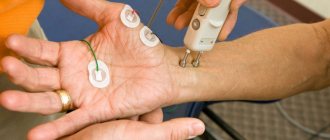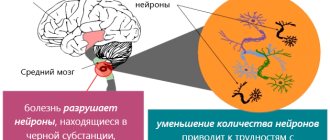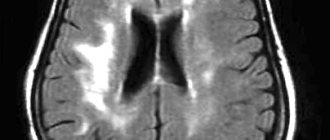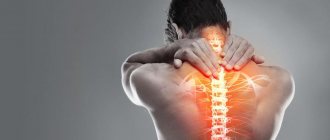Hypertonicity in a newborn: main signs
It is necessary to constantly monitor the behavior of the baby in order to detect violations and correct them in a timely manner. Parents should monitor their baby and contact a specialist if they detect the following characteristic signs:
· From 1-2 days after birth, the baby already holds his head, and does not lower it. · Cyclic regurgitation after eating, general loss of appetite, intestinal pain. · Heavy short sleep, during which tension persists: arms and legs are pressed tightly to the chest, the head is pulled back, and sometimes nervous spasms are observed. · The head throws back, the chin and arms shake convulsively while crying. · Very high excitability of the baby, he reacts painfully even to faint sounds and light, which act as irritants on him.
However, treatment of disorders is often started without in-depth diagnosis. Often, increased muscle tone is not an independent disorder, but a symptom of other diseases - cerebral palsy, congenital malformations of the brain, spinal injuries and hereditary pathologies.
In such cases, in addition to these signs, the child may have other neurological symptoms. Then treatment of the underlying disease will be required.
Hypertonicity can be detected by simply taking the baby by the arms and placing him on a flat surface. If a baby at 1-2 months begins to reflexively step and plant his foot completely, rather than walk on tiptoe, this may indicate increased tone.
It is important for parents to pay attention to whether the baby passes the main stages of development on time. By one month, the baby begins to briefly raise his head; at 2-3 months, he begins to hold it vertically for 5 minutes or more. One should be alarmed by the appearance of this skill either too late or too early. If a baby, already a month old, lies on his stomach for a long time with his head raised, this may indicate increased tone. You should definitely visit a doctor.
At 3 months, the baby already begins to roll over onto his side, and a full, correct turn is possible at 6 months; up to this point, if the baby turns, he does so through extension of the head. If a child masters flips only through the right or left side, parents should be wary. At the same age, the physiological tone of the flexor muscles naturally decreases. At first it decreases in the arms, and then in the legs. However, this condition is normal: in the absence of other complaints, the baby’s development occurs in accordance with age norms.
An important diagnostic criterion for hypertonicity in infants is tremor of the baby’s chin and/or limbs. Involuntary trembling should not be immediately alarming; it can be considered normal before the age of 4 months - for example, during crying, prolonged fussing, feeding or temperature changes. In such cases, the tremor is very short-lived and passes quickly. However, if the trembling occurs spontaneously and at rest, intensifies during crying and lasts for a long time, this may be a sign of hypertonicity, increased intracranial pressure or high convulsive readiness. In such conditions, the baby must be examined by a neurologist and, if necessary, prescribe additional examinations.
There are 3 types of hypertonicity: · Dystonic. This is a combined type that combines the symptoms of hyper- and hypotonicity. With this type of pathological condition, some muscle groups become overly tense, while others become very relaxed. Arms and legs with hypotonicity are usually relaxed, while those with hypertonicity are tightened. Dystonia can affect all muscles. · Symmetrical. This type of disorder is manifested by clenching of fists or fingers on both extremities. The pathology can cover the entire muscular system or be localized in the arms or legs. · Asymmetrical. There is severe tension on one side with normal symptoms on the other. The baby has characteristic clinical signs: he turns over on his side and squirms. The head is almost constantly turned to the side with increased muscle tone, which signals hypertonicity of the neck muscles. If only one leg bends in a supine position, this indicates high tone of the other leg. If there is asymmetrical hypertonicity, it turns the body towards the side with excess tone, and the torso will bend in an arc. Only symmetrical tone is a physiological norm; all other conditions are considered pathologies.
What does it look like
Tremor of the limbs and chin in babies, which often occurs during crying, is associated with a balancing excitation of the nervous system, which helps stabilize the state of the body. Twitching, which usually occurs due to stress, has a small amplitude and occurs at very short intervals.
We can say that tremor of the chin and legs in a newborn is a side effect of increased muscle tone. So for the first three months of a child’s life, small twitches are absolutely normal. In addition, this picture is directly related to the immaturity of the infant’s nervous system.
Also, tremors in newborns can be observed during the REM sleep phase. It looks like this - the child’s arms and legs shudder intensely, the eyes under half-closed eyelids often move.
A week after birth, the attacks of tremor gradually begin to disappear, appearing only with severe fear or a hysterical cry. If your child's limbs or chin tremble even in a relaxed state, you should consult a doctor.
Variants of the norm: what provokes tremor in newborns
If you notice involuntary trembling of your baby's chin or legs, you can safely attribute them to the immaturity of the nervous system or adrenal glands. In both the first and second cases, when overexcited or uncomfortable, the body reacts with a release of adrenaline, which provokes tremors. Discomfort refers to the baby’s dissatisfaction that arose during dressing, feeding, and bathing. For example, if the water in the bath is at an uncomfortable temperature - too high or low - the child may cry and his chin will tremble.
Tremors of the chin and limbs also often occur in newborns born prematurely. In premature babies, the peripheral and central nervous systems are even more immature than in full-term babies. And although they continue to develop outside the womb, the stress that the child received during premature birth can make itself felt in the form of twitching of the arms and legs.
In addition, if fetal hypoxia occurred during childbirth, the baby will most likely exhibit tremors up to three months. This condition is considered normal when crying or overexcitement. But if trembling of the limbs occurs involuntarily and continues after the child reaches three months of age, this is a serious reason to visit a neurologist.
When is tremor a pathology?
Tremor in newborns that occurs for no apparent reason may be evidence of certain diseases. In any case, if you notice suspicious symptoms, it would be a good idea to consult a neurologist and, on the advice of a doctor, examine the child.
Sometimes a newborn's chin tremor covers the entire head. If this is an isolated phenomenon explained by crying, there is no cause for concern. But if the tremors of the head, accompanied by hypertonicity of the neck muscles, are repeated again and again, we may be talking about a serious neurological illness. Involuntary head twitching can occur against the background of sepsis, intracranial hemorrhage, hypoxic-ischemic encephalopathy, hypocalcemia, hyperglycemia, hypomagnesemia, and drug withdrawal syndrome.
Chin tremor is, by and large, considered normal. But if it continues after three months, and is also accompanied by muscle dystonia, frequent regurgitation, lack of sleep and overexcitability, you should still consult a doctor.
Involuntary contractions of the limbs after leaving the neonatal period, occurring for no reason, should alert parents. For example, trembling hands may be a sign of thyroid dysfunction. Especially if the tremor is accompanied by insomnia, increased sweating, intestinal upset and colic. If such symptoms appear, you should show the child to an endocrinologist.
Sometimes mothers' leg tremors in newborns are confused with cramps that occur with hypertonicity. Only a doctor can determine the difference between these symptoms. So don’t neglect regular checkups with your pediatrician. In addition, tremor may be associated with increased intracranial pressure or hemorrhage, as well as abnormal structure of the foot or lower leg. Sometimes twitching of the lower extremities occurs after an injury.
Causes of hypertension
The development of hypertonicity is possible due to exposure to adverse factors during pregnancy, childbirth, or in the first weeks after them. During the prenatal period, the baby can be harmed by:
· prolonged hypoxia – insufficient oxygen supply; · acute infectious diseases suffered by a pregnant mother; · maternal abuse of alcohol, alcoholic beverages, drugs; · uterine tone, toxicosis and threat of miscarriage; · hemolytic disease of the baby caused by Rh conflict between mother and fetus; · perinatal encephalopathy; · genetic disorders; · pathologies of development of the brain or spinal cord.
Unfavorable environmental conditions, frequent stressful situations, infections, increased intracranial pressure, and injuries in the postnatal period can lead to pathological disorders. The cause of hypertonicity is often difficult, rapid or too long labor, as well as entanglement of the fetus with the umbilical cord. Birth injuries can disrupt the functioning of the central nervous system of infants and cause various disorders.
The baby's head is slightly larger than the diameter of the mother's birth canal, and since some parts of the skull bones are soft, it can change. Any obstacle or delay causes mechanical damage to the skull, which leads to impaired blood circulation in the brain structures and hypoxia. Intracranial pressure may also increase.
Hypertonicity is caused not only by birth, but also by physical trauma in later life. Any traumatic impact can cause a myotatic reflex - it leads to an increase in muscle tone to protect against potential damage (this is the body's natural defense mechanism). Thus, in whiplash injuries of the cervical spine, the neck muscles contract in order to immobilize the spine. The same reactions are possible with the muscles of the thoracic or lumbar region.
In the acute period of injury, the presence of hypertonicity is the norm, since it prevents re-injury of the vertebrae, discs, and ligaments.
Increased tone can also occur during stress. Even a quiet, sharp cry or fright of a baby often leads to hypertonicity of the following muscles: · occipital; · upper trapezoid; · diamond-shaped; · calf; · square lumbar.
Hypertonicity often causes pain in compressed blood vessels, as well as lymphatic and capillary congestion. After all, this is where metabolites—products of cellular metabolism—accumulate.
Why is hypertension dangerous?
Hypertonicity can be caused by disorders of the central nervous system. Without adequate treatment, such deviations worsen and develop over time: at first, infants experience disturbances in motor activity, then problems with fine and gross motor skills, coordination of movements, and speech functions appear. Possible disturbances in gait and posture, developmental delays. All this indicates that increasing the physiological tone of infants requires special control from parents. Timely detection of disorders and their etiological factors, as well as subsequent correct therapy, are the key to good health and normal development of the baby.
Pathologically high muscle tone interferes with the harmonious development of the child, delays the rate of motor development (the baby begins to roll over, walk, and sit late). The formation of the musculoskeletal system is disrupted, which in the future spoils gait and causes other pathological changes. Hypertonicity can also indicate the presence of serious neurological pathologies, which are very important to detect and eliminate in the early stages.
Treatment of increased physiological tone of the baby
Hypertonicity is a fairly common disorder in children, but an experienced pediatrician and pediatric neurologist can easily detect it. Sometimes the increase in physiological tone goes away on its own within 4-5 months. In addition to the main symptoms, experts study the following reflexes of the baby (in the case of normal development, they themselves disappear by the specified age):
· Step reflex. In an upright position, the child begins to walk on level surfaces. · Support. The baby places his foot on the entire foot, and not on his toes. · Symmetry/asymmetry reflex. In the supine position, with the chin pressed to the chest, the baby's legs extend and arms bend. When the head tilts to the right, the left limbs bend, and the right limbs bend to the left. · Tonic. In the position on the stomach, the arms and legs are bent, and in the position on the back - straightened.
The pediatrician often prescribes a set of procedures for children with increased physiological tone that only eliminate the main symptoms, but he does not find the true causes of the disorder and does not solve the problem. Neither drug treatment, nor aromatherapy, nor physiotherapeutic procedures as monotherapy affect the causes of pathology, therefore osteopathic treatment is considered the most effective treatment. Osteopaths view the body as a single whole, in which all organs and systems are interconnected. They can treat one system while working with another, revealing the cause of pathological changes. The osteopath's fingers are very sensitive and receptive, and the manipulations are extremely soft and careful. Therefore, osteopathic treatment is safe, painless and effective for hypertonicity. The specialist will ensure normal and full functioning of the child’s not fully formed nervous system.
When drawing up a therapy program, the doctor will compare the neurological symptoms with the overall development of the baby and, if necessary, prescribe additional examinations. Observing the child in dynamics, comparing the tone with his skills and abilities will allow you to make a final medical conclusion.
chin tremor in infant
There is an opinion that before the age of one year, every baby should undergo at least four courses of massage. But why is a healthy child, developing on time and without complaints from doctors, prescribed a massage? Maybe for reinsurance or from the principle of “don’t spoil the porridge with butter”? Considering that the prices for the services of a good children's massage therapist are quite decent and can significantly hit the family budget, it is understandable that mothers are not idlely interested in this issue. Let's look at it in detail!
From what age?
It is best to start when the baby is two months old. Moreover, an exception should not be made even for premature babies. It is enough to create more favorable conditions for them: for example, the air temperature in the room should not be lower than 25 degrees. In any case, before starting a massage, you need to show the child to three doctors: a neurologist, an orthopedist and a pediatrician, who make a diagnosis and give recommendations.
The fact is that there is one subtlety: drug treatment, if required, is also “adjusted” to the massage.
What is the need for massage?
Massage helps to correct many neurological and orthopedic disorders: hyper- and hypotonicity of muscles, feet turned inward or outward, clubfoot, poor leg extension at the hip joint. All infants have so-called “residual reflexes”. This is the Moro reflex, in which an overexcited child throws his arms to the side, and the Babinsky reflex, when, when the soles are irritated, the child reflexively begins to straighten his fingers. Normally, these reflexes should subside by 4 months. But for some children they do not go away or go away very slowly. Massage helps eliminate residual reflexes. In addition, with its help you can stop tremors - trembling of the hands, chin, and other parts of the body.
Massage techniques
The massage technique is selected depending on the type of residual reflex. For example, to eliminate the Babinsky and Moro reflexes, which manifest themselves in the child’s excessive excitability, a gentle massage is performed. In addition to massage, physical therapy is necessary, for example, rolling on a ball, folding into the “fetal position,” etc. With the Moro reflex, swaddling the baby can have an additional effect.
Gentle massage is also used to correct most residual reflexes, since they are associated with muscle hypertonicity, and therefore with excessive activity of the child. This massage relaxes and soothes, and the stimulating one activates the child. With muscle hypotonicity, the child is usually lethargic and cannot raise his arm and head. This condition is corrected by stimulating massage, with a large number of “chopping” movements.
Why massage for healthy children?
The strategic goal of infant massage is to prepare them for walking. From two months to one year, the baby must undergo at least 4 massage courses of 15-20 sessions each. When the child gets on his feet, the frequency of massage is reduced to 2 times a year. It is advisable to take courses in spring and autumn to improve the condition of the immune system, which is usually weakened at this time of year. Wellness massage is useful after illnesses.
After a year
Next, the massage serves to maintain immunity, improve metabolism, and activate blood circulation. Sometimes massage is used as an aid for constipation. It also has beneficial effects on the formation of bones, muscles and the nervous system. After all, after a year, a child may develop rickets due to a lack of vitamin D: the legs become X- and Y-shaped, and the bones become deformed. The massage tones the “muscle corset,” which helps support the child’s bones and internal organs. To correct the shape of the legs, it is necessary to relax the hypertonicity of some muscles and, conversely, strengthen others.
Massage is used as an aid for congenital heart disease, rheumatism, diabetes, cystic fibrosis, and obesity. Depending on the disease, the timing and massage techniques are selected.
Massage for coughs is very effective - “tapping” phlegm while simultaneously warming it up. Additionally, you can use breathing exercises. However, sometimes a cough can be a symptom of pleurisy. In this case, you should not “tap” the child: this can lead to “sticking” of the pleura.
How?
When massaging small children, it is better not to use scented creams with various additives, as they can cause allergic reactions. The usual domestic “Baby cream” will do. The main thing is not to smear the baby with oil like a sandwich, so as not to clog the skin pores through which the baby breathes. You just need to lubricate your hands so that they slide freely over the body. All movements are made from the periphery to the center, starting from the limbs. It is very useful to press with two fingers along the child’s spine, from bottom to top. Every mother can do this. For hypertonicity, planar stroking is used, that is, with the entire surface of the palm, and enveloping (with the entire hand) when massaging the arms and legs. After stroking, rubbing is done - circular movements with the pads of one or four fingers or the ulnar edge of the hand. Each massage should be completed with stroking.
In principle, it is not necessary to resort to the paid services of a specialist unless there is an urgent need for it - medical indications. Any mother can easily give her baby a massage; to do this, she needs to know the basic rules of massage at home.
Pre-ventilate the room and make sure that the temperature is not lower than 22 °C.
Prepare the place - an ordinary table is covered with a blanket folded in four, an oilcloth (in case of any troubles) and a diaper.
Wash your hands with warm water and dry them (they must be warm), remove all jewelry (rings, bracelets). Of course, nails should be cut short.
It is better to massage during the day, at least an hour after feeding. It is not recommended to exercise immediately before feeding and after bathing. You can’t do a massage if the baby doesn’t feel well, or if the exercises cause him negative emotions: the baby cries, winces, resists.
In the first lessons, each movement and exercise is repeated only once, but after a few days - three or four times.
Now, as for the means at hand: talc and petroleum jelly are not needed - they clog the pores.
Use the following massage techniques: stroking - light sliding, smooth movements with the palm or the back of the hand. This is how the massage begins and ends. Then - rubbing with short circular movements. Hands no longer just glide over the skin, but come into close contact with it. Rubbing the back, hips, and abdomen is usually done with the palm of your hand. On the legs, arms - with the tips of the fingers.
Finally, kneading is short movements of the fingers, with stronger pressure. It affects not only the skin, but also muscles, joints, and tendons. It would be nice to combine all these techniques. All movements go from the periphery to the center: from the hand to the shoulder, from the foot to the groin. The abdomen is massaged in a clockwise circular motion. This is usually done for therapeutic purposes: for constipation, umbilical hernia. Next, place the baby on his stomach, place his arms or a rolled-up diaper under the chest and stroke the back with the palms of both hands from the head down, and the back of the baby back. Stroke the soles with your thumb and then pat them. The baby should be calm at this moment, you need to talk to him kindly, and watch his reaction. When the first signs of fatigue appear (displeased grimaces, crying), you need to stop exercising.
The complex for the tiniest ones - from one and a half to 3 months - takes only 4-5 minutes.
We stroke the legs from the toes up along the outer surface of the lower leg and thigh, then the arms, also from the bottom up from the toes to the shoulder. Then, with your entire palm, preferably both hands, stroke the breast from the middle to the sides, and then with your fingers along the intercostal spaces.
From 3 months, massage is combined with gymnastics, and it should take 8-10 minutes. And the exercises are very simple: crossing your arms on your chest and spreading them to the sides (4-6 times); turn from back to stomach left and right (1-2 times in each direction); lifting by the legs from a prone position; “dance” - the baby is held upright, under the arms, and he moves his legs.
At 4 months the baby already turns on its side, from 5 months - on its stomach, from 6 - from its stomach to its back, lying on its stomach, and even tries to crawl. Therefore, at 4-6 months, the previous exercises are performed a greater number of times (6-8), and flexion and extension of the arms and legs are added to them; squats; sliding “steps” - 10-15 steps; “boxing” - 8-10 times; lifting the body with support from both outstretched arms 1-2 times.
After 6 months, a child moves a lot, tries to sit down, and from about 7 months begins to sit without support and can change body position without outside help. By 8-9 months he can already stand on his feet and walks along the arena. And so the gymnastics becomes more complicated: crawling is added; raising straight legs 6-8 times; lifting the body from a position on the stomach with support from the arms (1 time); circular movements with hands; turn from back to stomach; stepping with the support of the hands.
At 9 months, the baby is already sitting well, standing with support, or holding on to something, taking his first steps. Therefore, the last complex (9-12 months) includes new exercises: active raising of straightened legs from a supine position; stomping; independently turning from back to stomach at the sight of a beautiful toy; active bending and straightening of the body; squat; walking. One of the active movements, for example, is performed like this. The child lies on his back. The mother lets him wrap his thumbs around her hands, and then spreads his arms to the sides. By slightly pulling the baby towards her, the mother encourages him to sit down. Then he carefully places it on the table. The exercise is repeated 3-4 times.
All this is quite accessible and feasible, if the mother wishes to act independently. By the way, the child perceives a massage from the mother as affection and is less likely to resist, as happens during visits to the local pediatrician in the clinic.
Features of osteopathic correction
A decrease in blood flow is usually caused by mechanical factors. A child’s brain grows and develops very quickly; at such a pace, it is important to eliminate hypertonicity at the earliest stages. This is also due to the fact that the younger the baby, the softer its bones, and the easier it is to deal with mechanical factors. Doctors at the Quality of Life clinic successfully eliminate the problem, which creates conditions for the normal growth and development of the child in accordance with age standards.
Osteopathy considers increased physiological tone as a disruption of the spinal cord and brain. This leads to the fact that the muscles receive excessive stimulation, resulting in their hyperfunction. Hypertonicity can affect both individual muscle groups and the entire musculature of the body, which is observed with cerebral palsy.
Osteopathic treatment in our clinic is aimed at: · balancing the bones of the skull; · elimination of stress from the hard shell and hemispheres; · relieving muscle tension; · ensuring the full functioning of the nervous system. This allows you to completely normalize the baby’s physiological tone.
The first year of a child’s life is the most effective for the treatment of neurological disorders, including hypertonicity, so therapy should be started as early as possible. However, our osteopaths will eliminate increased tone even in case of late treatment.
Osteopathic correction of hypertonicity does not cause pain or discomfort in the newborn, therefore it is absolutely safe. The positive effect will be noticeable after 1-2 sessions; the baby will improve not only muscle tone, but also appetite, sleep, and digestive processes will be normalized. An experienced osteopath triggers important self-regulation mechanisms of the body, which correct the functioning of brain centers and metabolic processes between them.
We offer: · Individual treatment programs. When developing a strategy, the physical characteristics of not only the child, but also the mother are taken into account. The nature of pregnancy, difficulties during pregnancy, the presence of concomitant disorders, and general health are taken into account. · Supervision after therapy. The treating specialist is always in touch, monitors the results of the therapy, and provides recommendations for maintaining health with hypertension.
After the therapy, we develop individual sets of exercises for independent training with a child with hypertonicity, if there is such a need.
When drawing up a treatment program, the doctor will compare the neurological symptoms with the overall development of the baby and, if necessary, prescribe additional examinations. Observing the child in dynamics, comparing the tone with his skills and abilities will allow you to make a final medical conclusion.
The baby's body is a perfect system that strives to be healthy. The osteopath’s task is to activate and direct self-regulation processes so that the baby can independently maintain balance, and parents can follow medical recommendations. The osteopathic correction methods used in our clinic create a synergistic effect that provides excellent results in eliminating increased tone in children of any age. Our task is not to prescribe a child the maximum number of procedures, but to offer, from a wide range of osteopathic medicine options, exactly those that he really needs. We treat, not heal, we do it safely, effectively and comfortably.
In addition to osteopathic treatment, other techniques are also used in complex therapy. Thus, water is an ideal environment in which muscles and ligaments completely relax. Therefore, as early as 1 month, newborns can be bathed in a large bathtub.
You can teach him to float on his back and on his stomach in the bath. When your child gets older, you can start visiting the pool with him. Herbal baths are also extremely useful.
To do this, you can use special mixtures for children or decoctions of sage, motherwort, lingonberry, and valerian root. The bath should be warm, different decoctions can be alternated with one-day breaks.
Consequences of tremor in a newborn
With physiological tremor, parents should not worry and exhaust themselves with frightening assumptions. The child is not in any danger, and apart from minor twitching of certain parts of the body, this does not affect his development and health in any way.
Up to 3-4 months this feature will disappear on its own. In some children, it completely disappears by the age of one year. Upon reaching this age, the nervous system is strengthened, so there is no trace of the problem.
In the case of pathological tremor, things are somewhat different. In addition to the fact that he needs constant monitoring, he also needs special treatment.
When talking about possible consequences, you need to understand that they completely depend on which part of the brain is affected. There is a possibility that the child will become completely healthy. And in some cases this can result in:
- Intellectual development disorder
- Development of cerebral palsy.
In order to avoid such consequences, you should not hesitate when tremor appears. A visit to a specialist will help determine the cause of its occurrence and possible solutions to the problem. Timely treatment and compliance with the recommendations given by the neurologist will increase the chances that tremor will not affect the child’s health and development.


